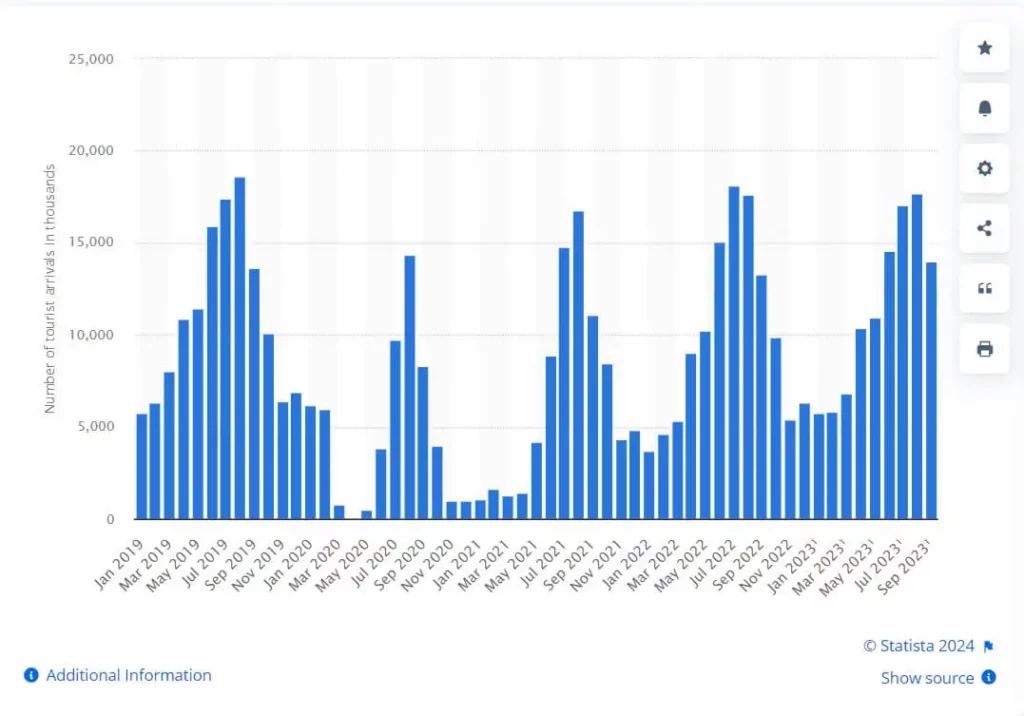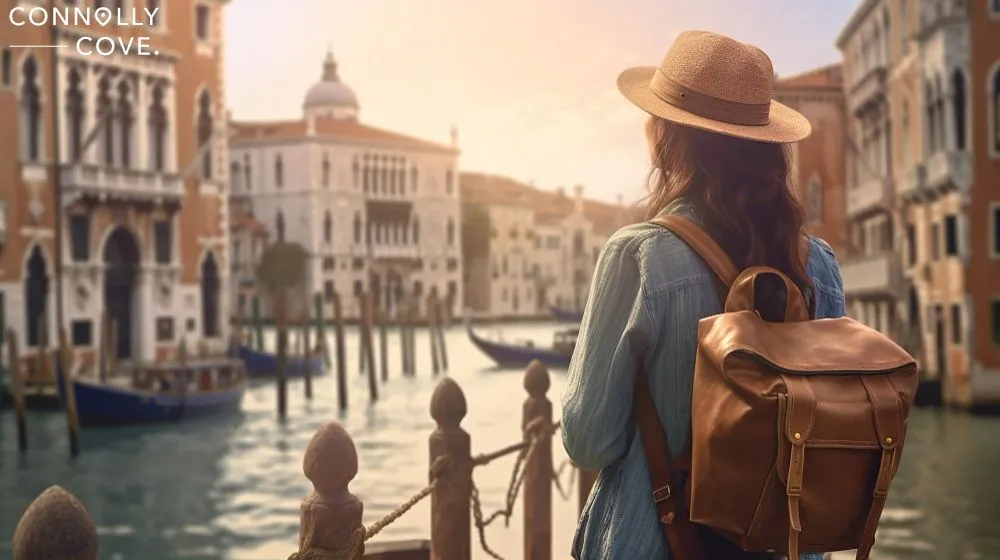Beyond Pasta and Piazzas: Decoding Italy’s Tourism Statistics

Updated On: April 08, 2024 by Yasmin Elwan
Italy has long been synonymous with romance, history, and unparalleled beauty. But what lies beneath the surface of its postcard-perfect landscapes? Let’s set aside the guidebooks and dive into the interesting tourism statistics in Italy. Beyond the iconic landmarks and mouthwatering cuisine lies a treasure trove of data that unveils the true essence of Italy’s allure. Join us as we unravel the numbers behind Italy’s tourism scene, revealing insights that will surprise and inspire.
Italy’s Tourism Landscape
Italy, a nation sculpted by time and nature, boasts a tourism landscape as rich and diverse as its rolling vineyards and ancient piazzas. From the awe-inspiring ruins of the Roman Colosseum to the breathtaking vistas of the Cinque Terre coastline, Italy offers a captivating blend of historical significance, artistic treasures, and culinary delights.
A Legacy Steeped in Travel
Italy’s love affair with tourism stretches back centuries. The Grand Tour, a rite of passage for European elites during the 17th and 18th centuries, cemented Italy’s position as a cultural and artistic mecca. Grand Tour travellers marvelled at the Renaissance masterpieces, explored the remnants of a glorious past, and savoured the regional specialities that continue to tantalise taste buds today.
A Modern Powerhouse of Hospitality
Today, Italy flourishes as one of the world’s top tourist destinations. Millions flock annually to experience its vibrant culture, indulge in its world-renowned cuisine, and soak in the sun on its idyllic beaches. Beyond the iconic landmarks, a network of charming villages, historic towns, and breathtaking natural landscapes beckons exploration.
However, the industry isn’t without its challenges. Issues like infrastructure development and sustainable tourism practices are being addressed to ensure that Italy’s magic continues to captivate visitors for generations to come.
Key Tourism Statistics in Italy

If you have ever been to Italy during peak seasons, you most likely have noticed the huge crowds filling the Italian streets and piazzas, but have you ever wondered how many are these people? And why do we even care about their numbers? Here are some answers for you:
A Nation Welcoming Millions
Pre-pandemic, Italy boasted a staggering 94.3 million international tourist arrivals in 2019 (source: Statista). While the COVID-19 pandemic undoubtedly impacted these numbers, 2022 saw a significant recovery, with 74.7 million international visitors (according to Statista). This signifies the enduring appeal of Italy as a travel destination.
While Italy’s iconic cities like Rome and Venice remain top draws, regional gems are gaining traction. Tuscany, with its rolling vineyards and charming hilltop towns, is a popular choice. Southern regions like Puglia and Campania are also attracting visitors seeking pristine beaches and rich cultural experiences.
Who Visits Italy and Why?
Italy caters to a diverse range of travellers. Statistics indicate a mix of age groups, with younger backpackers drawn to budget-friendly options and older generations seeking cultural experiences. Europeans traditionally make up a significant portion of visitors, with Germany, France, and the United Kingdom consistently ranking high. However, the US and Asian markets are also growing.
The purpose of the visit varies – some seek historical immersion, while others prioritise culinary delights or outdoor adventures. Business travel also plays a role, with Italy’s fashion and design industries attracting international professionals.
Evolving Accommodation Choices
Italy’s accommodation sector is adapting to changing preferences. While traditional hotels remain a mainstay, vacation rentals are gaining popularity, particularly among families and groups seeking more space and a home-away-from-home experience. Hostels continue to cater to budget-conscious travellers, especially younger demographics.
The Rhythm of the Seasons
Seasonality significantly impacts Italian tourism. Summer is peak season, with throngs of visitors seeking sunshine and beach vacations. Shoulder seasons (spring and fall) offer pleasant weather and potentially lower prices, attracting those seeking a more relaxed experience. Winter sees a dip in tourist numbers, except in mountain regions popular for skiing. Understanding these trends allows tourism businesses to cater to specific visitor preferences throughout the year.
The Economic Powerhouse of Tourism in Italy
Tourism isn’t just about admiring ancient ruins and indulging in delicious pasta – it’s a significant economic engine for Italy. Here’s a breakdown of its impact:
- Job Creation: Pre-pandemic tourism directly employed 2.1 million people in Italy, contributing to 8.8% of total employment (according to OECD). This encompasses jobs in hotels, restaurants, transportation, cultural sites, and various travel services.
- Revenue Generation: In 2019, tourism directly accounted for 6.2% of Italy’s Gross Value Added (GVA), translating to a whopping €99.9 billion. This includes tourist spending on accommodation, food, transportation, souvenirs, and activities.
- Indirect Impact: The ripples of tourism extend far beyond direct spending. It supports local businesses like artisan shops and farms, boosts infrastructure development, and promotes Italian exports of food and fashion.
Why Tourism Stats Matter
Knowing these statistics helps us understand the following:
- Economic Importance: Tourism is a crucial pillar of the Italian economy. By monitoring tourist numbers and spending patterns, policymakers can make informed decisions about infrastructure investments, marketing strategies, and regulations to ensure its continued success.
- Regional Development: Tourism statistics highlight popular and less-visited regions. This allows for targeted development initiatives that spread the economic benefits of tourism to areas beyond major cities.
- Sustainability: Analysing tourist demographics and preferences helps promote responsible tourism practices. Understanding seasonality allows for better management of resources and infrastructure to avoid overcrowding and environmental damage in popular destinations.
- Future Trends: By tracking tourism trends, businesses in the hospitality sector can adapt their offerings and cater to emerging traveller preferences, ensuring they remain competitive and meet evolving expectations.
Best Practices for Travellers in Italy

Venturing into a new country can be daunting. Fear not, intrepid explorer! Here’s a comprehensive guide packed with best practices to ensure your Italian adventure is as smooth and delightful as a perfectly cooked plate of pasta.
Planning and Preparation
- Visas and Documentation: Research visa requirements well in advance, especially if you plan on staying longer than 90 days or travelling for work. Ensure your passport has at least six months of validity remaining. Pack a photocopy of your passport’s main page in case of emergencies.
- Currency Exchange: While credit cards are widely accepted, especially in larger cities, carrying some Euros in small denominations is always helpful for smaller purchases and street vendors. Familiarise yourself with the current exchange rate to avoid unfavourable deals.
- Learn Basic Italian: Mastering a few key phrases like “Buongiorno” (good morning), “Grazie” (thank you), and “Scusi” (excuse me) goes a long way. Locals appreciate the effort and may even offer friendly conversation. Phrasebooks and mobile translation apps can also be lifesavers.
- Pack Smart: Research the weather conditions for your travel dates. Pack comfortable shoes suitable for walking on cobblestone streets. Remember, many churches and restaurants have dress codes, so pack a lightweight scarf or cardigan to cover shoulders if needed.
Transportation Tips
- Public Transportation: Italy boasts a well-developed network of trains, buses, and trams within cities and connecting major destinations. Purchase tickets in advance, especially for high-speed trains, to avoid queues and potentially save money. Validate your tickets before boarding on regional trains.
- Navigating Cities: Walking is the best way to explore most Italian cities. Download offline maps or purchase a local map to navigate charming alleyways and hidden gems. Taxis are readily available but can be expensive. Consider purchasing a travel card for discounted fares on public transportation within the city.
- Driving in Italy: If you choose to rent a car, be aware of ZTL zones (limited traffic zones) in city centres. International driving permits are recommended, and defensive driving is essential. Parking can be tricky, so consider exploring cities on foot or using public transportation.
Cultural Considerations
- Siestas and Mealtimes: Many shops and businesses close for a siesta in the afternoon, typically between 1 pm and 4 pm. Restaurants have designated lunch and dinner hours – plan your meals accordingly. Don’t expect a quick bite; Italians savour their food, and meals are often a social experience.
- Tipping Etiquette: Tipping is not mandatory in Italy, but a small gratuity (servizio) is appreciated for good service at restaurants. Usually, a round-up to the nearest Euro or leaving a few Euros on the table is sufficient. Service charges are sometimes included in the bill, so check before adding extra.
- Respecting Dress Codes: While casual attire is generally accepted, avoid overly revealing clothing when visiting religious sites or upscale establishments. Opt for modest clothing that covers shoulders and knees.
Staying Safe and Secure
- Petty Theft: Be mindful of your belongings in crowded areas like train stations and tourist attractions. Keep valuables like wallets and passports secure in a money belt or crossbody bag worn in front of you.
- Scams: Unfortunately, scams can target tourists. Be wary of individuals offering unsolicited “help” or overly friendly street vendors pushing overpriced goods. Do not exchange money on the street; stick to reputable exchange offices.
- Emergency Numbers: Store emergency contact information in your phone. The national emergency number in Italy is 112.
Embrace the Experience
- Go Beyond Tourist Traps: While iconic landmarks are a must-see, venture beyond the usual tourist trails. Explore charming side streets, visit local markets, and experience the authentic heartbeat of Italian towns.
- Learn from Locals: Don’t be afraid to interact with locals. Italians are generally friendly and appreciate genuine interest in their culture. Even basic Italian phrases can open doors to unique experiences and recommendations.
- Embrace the Pace: Slow down and savour the moment. Italy is all about enjoying life’s simple pleasures. Relax at a cafe, sip on an espresso, and soak in the vibrant atmosphere.
By following these best practices and embracing the spirit of “la dolce vita” (the sweet life), you’re well on your way to crafting unforgettable memories in Italy.
Italy’s tourism industry is constantly evolving. By analysing these key statistics, stakeholders can work towards sustainable practices that preserve Italy’s cultural heritage and natural beauty while ensuring a positive experience for future generations of travellers.






